Sony Xperia 1 Review
Sony Xperia 1 Review
Is a 21:9 screen and triple camera enough to win you over?
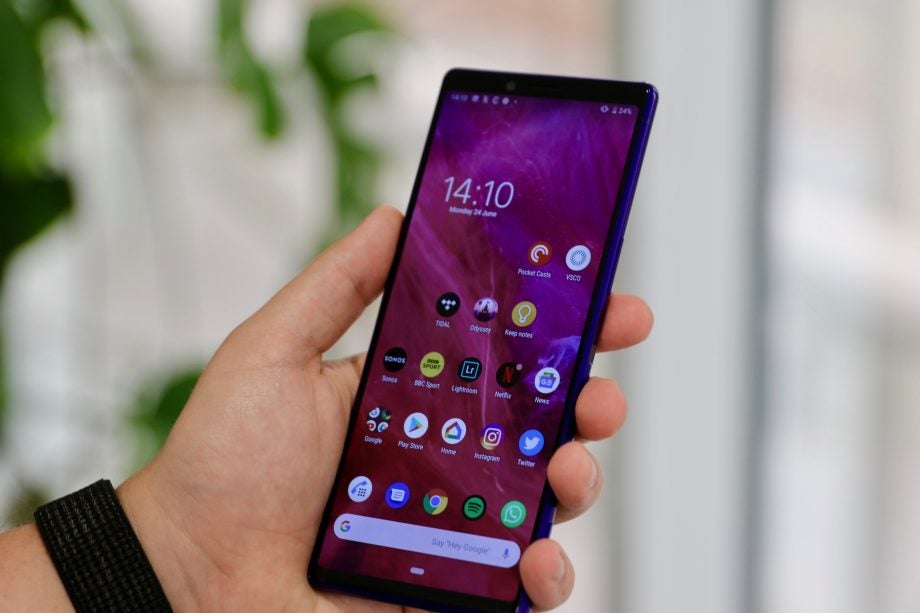
Sections
- Page 1 Sony Xperia 1 Review
- Page 2 Camera Review
- Page 3 Battery Life Review
- Page 4 Screen Review
- Page 5 Performance Review
Verdict
The best Sony phone in years and a unique approach that should deservedly win fans.
Pros
- The best camera we’ve seen on a Sony phone
- Unique design sets it apart from the crowd
- Nice screen
Cons
- Cons: The 21:9 display won’t be for everyone
- Camera still remains behind the best
- Battery life isn't great
Key Specifications
- Review Price: £849
- 6.5-inch 21:9 4K HDR OLED
- Qualcomm Snapdragon 855 SoC
- 6GB RAM
- 64GB w/ microSD up to 512GB
- Side-mounted fingerprint sensor
- 8-megapixel front-facing camera
- Android 9.0
- Triple 12-megapixel main camera
- 3330mAh battery w/ PD3.0 fast charging
The Sony Xperia 1 doesn’t play by the rules set out by the Samsung Galaxy S10, Huawei P30 Pro and iPhone XS. By doing things differently, it focuses on a different audience and – ultimately – (mostly) impresses.
This isn’t a mainstream phone and it certainly isn’t for everyone. For example, the 2:1 aspect ratio display makes for an unwieldy handset that takes some getting used to. However, I can’t help but be impressed by the fact that Sony has tried to do something different – and mostly succeeded.
Yes, the Sony Xperia 1 display is 4K, OLED and HDR – It still isn’t the best out there, though
Sony has included 4K screens on its devices in the past, starting with the Xperia Premium and continuing with the XZ2 Premium. Neither of those panels really used that resolution to its true potential, though – and, ultimately, it felt like wasted tech that jacked up the price of an average phone.
Things are far more positive here. The most notable upgrade is the switch from LCD to OLED, providing better contrast, perfect blacks and generally richer colours.
The aspect ratio, too, moves from the 18:9 that you’ll find in many other flagships to 21:9. This stretched-out aspect ratio makes for a very tall phone, but also one that’s ideal for content shot at 21:9. It’s a shame then that content actually made for this screen is lacking; you’ll usually find yourself stretching out regular 16:9 or 18:9 footage to fill the whole screen (unless you’re happy with black bars, that is).
Some of Netflix’s original content is shot at 21:9, which is great, but even on a screen such as this I’ve found it difficult to become fully immersed in a film when it’s only 6.5 inches wide. I’m more likely to watch a few YouTube clips or short TV episodes, but these don’t look as good. You’re likely to appreciate the Sony Xperia 1 more if you like watching movies on phones.
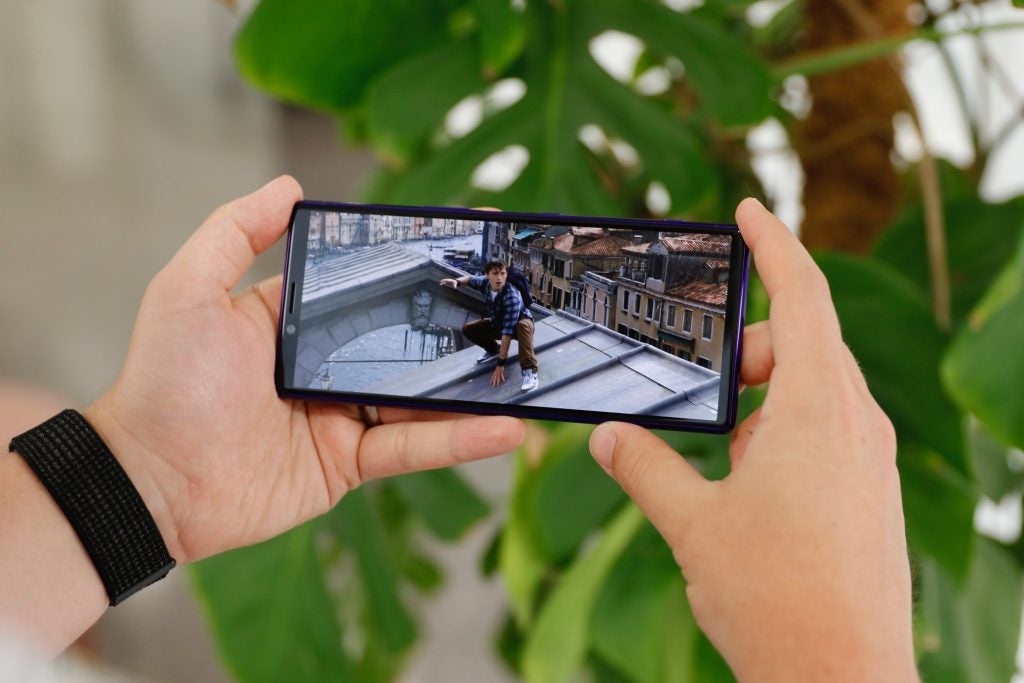
Spiderman: Far From Home trailer playing in 4K
The 4K and HDR support is a little confusing. HDR content is available through Netflix and Amazon Prime with the correct subscription and it looks great, while YouTube will play content in both 4K and HDR (again, if the video supports it). Now, Sony reps told me Netflix and Amazon will both play content in 4K – but, for me, they don’t. Amazon limits even 4K content to 1080p (it shows a 1080p badge in the bottom corner) and Netflix seems to do the same.
I’m not even convinced that much resolution is required on a phone with a 6.5-inch display. Playing a 4K video on YouTube next to 1440p content on a OnePlus 7 Pro and Galaxy S10 didn’t reveal much extra detail. In fact, I preferred how the image was presented on the none-4K phones thanks to the more familiar aspect ratio.
The Sony Xperia X1 can’t compete with the best in the business in terms of pure display quality, either. While colour gamut, brightness levels and such are fine – I’ve achieved more complete results from competing Android devices. You can see a full breakdown of this on our Sony Xperia 1 screen review page.
There are two screen modes on the Xperia 1: a “Creator” mode and a “Standard” mode. By default the phone is in Standard; however, Creator mode aims to “provide a faithful reproduction of the creator’s intended vision”. The Creator mode is softer on the eyes, displays a more orangey hue, and doesn’t present as much of an artificial tone.
There’s plenty going on with this display, and depending on the tasks for which you use the phone, you’ll either love it or just wish for something a little more mainstream. It isn’t the most accurate display around, but it’s good for watching media, especially content that’s made for this 21:9 screen.
Xperia 1 design is different, with the 21:9 aspect ratio making it taller than the competition
While the tall 21:9 display has its benefits for certain types of videos, I don’t think the trade-off for usability in worth it. This is certainly true for me; your mileage may vary and, depending on how you use your phone, it might actually offer an improvement.
The Xperia 1 is the tallest mainstream phone I’ve used. Line it up next to other large flagships such as the iPhone XS Max, OnePlus 7 Pro and Samsung Galaxy Note 9 and it sticks out as the odd one out. Yet, it doesn’t feel as big as those phones as it’s narrower. This means while it’s virtually impossible to move your thumb from the bottom to the top, overall the phone is easy to grip and doesn’t feel at all like it’s going to fall out of my hands.
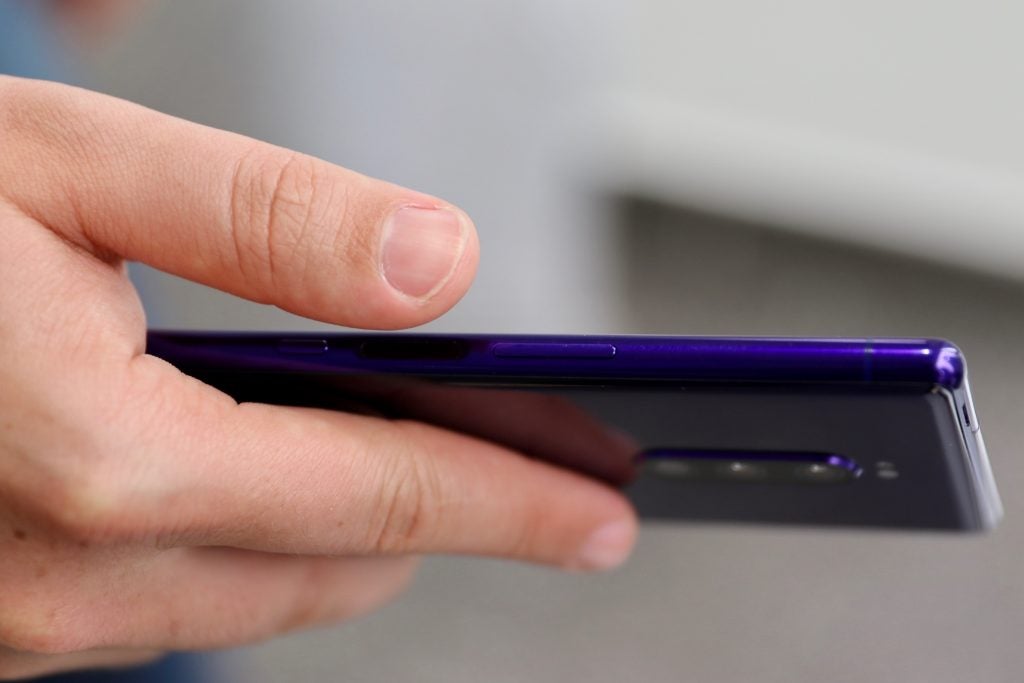
There’s a fingerprint sensor on the side
Still, there are some odd design choices here. The biggest in my opinion is the sheer number of buttons along the device’s right side: camera shutter, fingerprint sensor, lock key and a long volume rocker. I’m completely for these side-mounted fingerprint sensors, and the one here is super-quick and far superior to any in-display alternative, but it needs to incorporate the lock switch, too, as it does on the Samsung Galaxy S10e and Honor 20 Pro.
Along the top is a SIM and microSD slot, while the USB port for charging sits along the bottom edge.
It’s a well-built phone that has soft, curved edges and a light body. It feels far more “plasticky” than the iPhone XS or Samsung Galaxy S10, for example. However, as a result of this it feels less delicate, too: I’ve already dropped the Xperia 1 a couple of times and it’s barely picked up a scratch. Drop the iPhone XS once and you’ll certainly see some shards of glass.
The Xperia 1 software does a good job at making the tall display make sense
To really put that tall display to good use, Sony has heavily tweaked its Android skin. There’s much focus on easy multitasking, with that extra screen real-estate giving you more room than normal to have two apps sitting side-by-side.
Multitasking here still leaves you with fairly small portions of each app to use, but you can cram in more – in a more usable way – than you would on a phone with a squatter, wider screen.
App support, in general, is fine with the new aspect ratio. You won’t find many apps that don’t automatically resize – although it’s more common to see black bars running down either side of the panel in certain games – and you have the option to manually stretch video in apps such as Netflix and YouTube.
Some of the less convincing software tweaks come in the form of a number of Sony feature brought from the previous Xperia XZ3 flagship. Side Sense, in theory, allows you to tap the sides of the phone to initiate a number of actions including a pop-up app menu and to shrink the homescreen into a one-handed mode. In practice, it’s doesn’t work properly. Sometimes, it will burst into life with the slightest touch; other times, it doesn’t respond to even a hard jab.
Another Sony software addition is Dynamic Vibration – and it’s about as successful as Side Sense. The idea here is that this system adds haptic responses not only when you receive messages or calls, but when there’s sound playing from a video or game. I have to say it’s super-odd trying to immerse yourself in a film whilst having the phone spew out random vibrations. Even with the vibrations turned down to their lowest it was an annoyance.
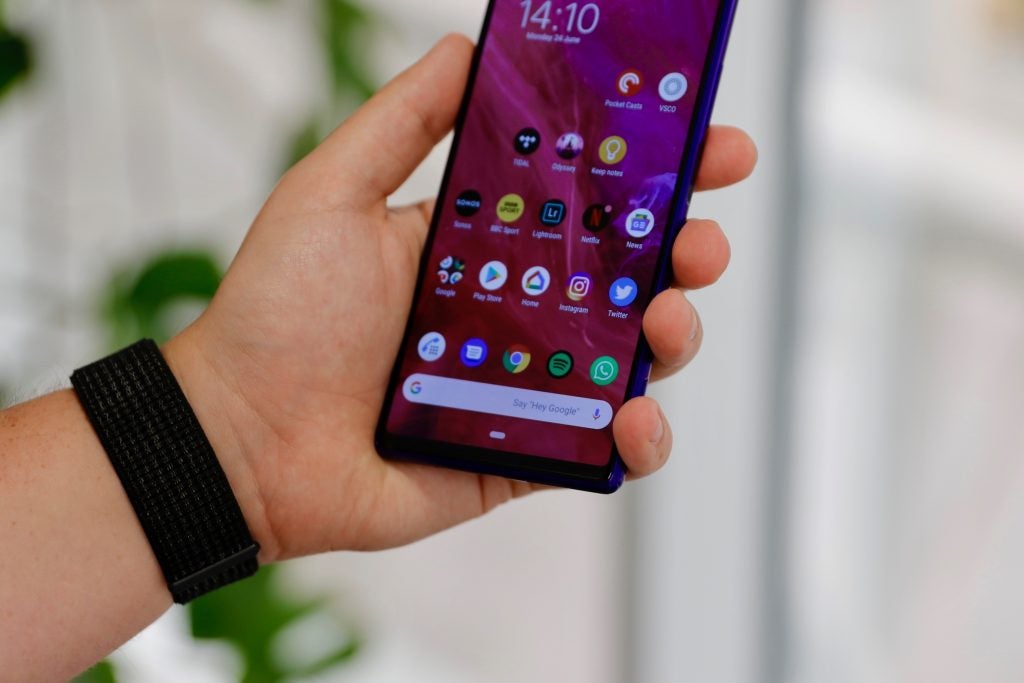
The Android UI is nice and clean, even if there’s plenty of bloatware
Thankfully, Sony has refreshed its once-ugly Android UI, turning it into very much a tweaked version of the software you’ll find on a Google Pixel. Of course, it’s still home to plenty of useless bloatware, but the overall look is slick and clean. I like the introduction of swipe gestures to pull down the notification panel (required on a screen this tall), and you can switch back to the traditional set of three Android soft-keys if you want.
Related: Best Android phones
The Sony Xperia 1 camera setup is the best of any Sony phone so far, if not quite the overall king
The Xperia 1’s triple-camera system gives it the photographic firepower to compete with its flagship rivals, although it doesn’t quite blow them out of the water.
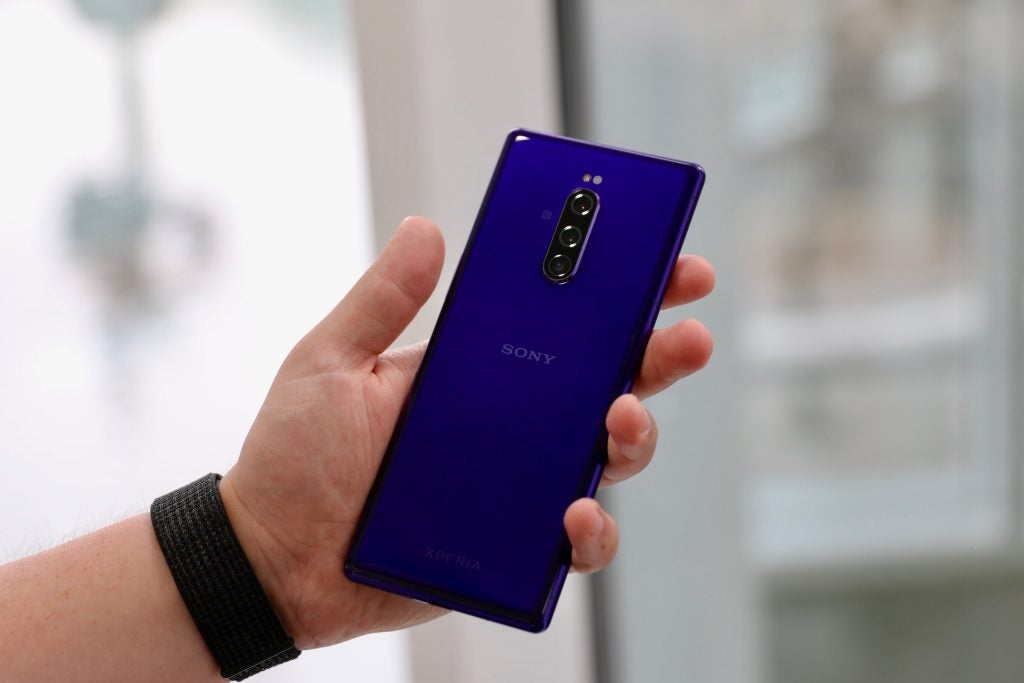
Three cameras sit on the back
Alongside the main 12-megapixel camera, which has a bright f/1.6 aperture, there’s a 52mm option for 2x optical zoom, plus a handy 16mm wide-angle lens for squeezing that soaring architectural masterpiece into your shot.
The Xperia 1’s strengths are shooting pleasingly natural daylight shots, impressive portraits and stabilised 4K video.
Its Eye AF feature (taken from Sony Alpha cameras) works well, without making a dramatic difference to your snaps, while the distortion correction option on its wide-angle photos makes that mode much more useful than on other phones.
Sony Xperia 1 (left) vs Google Pixel 3 (right) (use the slider to jump between the two sample photos)
The Google Pixel 3 and Huawei P30 Pro are still better all-rounders for daily shooting. The Pixel 3’s auto-HDR processing remains the best around, while the P30 Pro has 5x optical zoom. Note that the Xperia 1 lacks any kind of night mode for getting usable results when the lights are down.
Still, shots from Sony’s flagship might be more to your taste if you prefer subtler image processing. And it’s one of the best phones for shooting video, particularly if you like tinkering with colour-grading or pulling focus while shooting.
Its combination of optical and electronic stabilisation works very well for handheld walking videos, while the Cinema Pro app gives you various levels of control (manual focus, shutter speeds, pro ‘looks’ like Venice CS) that you can’t really find elsewhere.
The Xperia 1’s camera experience could do with a little extra polish and consistency. The manual mode, for example, is only available on the main 26mm camera, and annoyingly you don’t get Eye AF on the front camera, where it could prove most useful.
But the photographic experience is a real improvement on previous Xperia phones and makes the Xperia 1 a powerful all-rounder to have in your pocket for both stills and video.
Related: Best camera phones 2019
Sony Xperia 1 performance is as good as other 2019 flagships – although don’t expect 5G support
5G is the buzzword of the moment. EE’s next-gen mobile network is live in the UK, with Vodafone following in July and Three confirmed to hit before the year is up. 5G phones are here, too: OnePlus 7 Pro, LG V50 ThinQ and Samsung Galaxy S10 5G all take advantage of the faster speeds. While Sony teased a 5G phone earlier in the year, the Xperia 1 is plain-old 4G LTE capable.
Related: 5G in the UK
It’s high-end in other ways, though. There’s a Qualcomm Snapdragon 855 chipset running the show, backed by 6GB of RAM and 128GB of storage (expandable via microSD) – all pretty run-of-the-mill stuff for 2019.
These are speedy specs with performance to match, although I’d be disappointed with anything less. Coming over from the OnePlus 7 Pro with its ridiculously fast 90Hz display, the Xperia 1 does feel slower when scrolling – but then that’s the case for every phone I use. Would I take that higher refresh rate over fancy extras such as a 4K display? Yes, without a moment’s hesitation. The addition of 4K doesn’t make too much difference, whereas that jump from 60Hz to 90Hz impacts everything you do on the phone.
There’s no headphone jack – hardly a surprise in 2019 – so it’s a benefit that the Dolby Atmos-enabled speakers offer a good hit of sound. Call quality is strong, too, and the mics do an excellent job of cancelling out excess background wind and noise.

Performance is comparable to other flagships
Does a “small” battery lead to poor Xperia 1 battery life?
Many of the 2019 flagship phones we’ve seen so far have come packing huge batteries. You have the OnePlus 7 Pro and Huawei P30 Pro whose cells hit 4000mAh, and I’d expect the upcoming Note 10 to match that. It might seem odd, then, that the Xperia 1 comes with a 3300mAh battery – especially when there’s that 4K display to power.
After using the Xperia 1 for a couple of weeks it’s clear that the battery isn’t terrible; but it isn’t great, either. I’d put it on par with the smaller Samsung Galaxy S10, which normally gives me between three and four hours of screen-on time per day. I’d class myself as a heavy user (it comes with the job…), so depending on your usage – and really how much content you watch on the display – this will vary significantly. An hour of HDR Netflix streaming consumed 12%, which is higher than I’d have expected.
There’s no wireless charging here, which is a real shame. The handy nature of just being able to pop a phone down on a Qi-enabled pad and have it juice up is something that’s difficult to be without once you’ve become used to it. There’s no special form of fast-charging – such as OnePlus Warp Charge or Oppo’s Super VOOC – either. Instead, Sony has opted to utilise the USB PD standard. I like this approach since it allows you to fast-charge the phone with any number of USB-C chargers. A full charge takes around 90 minutes (roughly the same as the Samsung Galaxy S10).
Should I buy the Sony Xperia 1?
The Xperia 1 is directly aimed at fans of the iconic Sony brand and those bored with the current state of similar-looking smartphones. It does thing differently – for better or worse.
There’s no doubt this is the best camera Sony has ever put on a phone and it’s the finest display I’ve seen on an Xperia phone, too. That being said, the Pixel 3 still has a better camera and the OnePlus 7 Pro a better display.
Unlike previous Xperia phones, there’s nothing to seriously put me off the Xperia 1. The battery life isn’t world-beating, but it’s fine; the software is much cleaner than it used to be; plus I appreciate the physical fingerprint scanner. In my opinion, the only true missing feature is wireless charging.
Verdict
The best Sony phone in years and a unique approach that should deservedly win fans.
How we test phones
We test every mobile phone we review thoroughly. We use industry standard tests to compare features properly and we use the phone as our main device over the review period. We’ll always tell you what we find and we never, ever, accept money to review a product.


